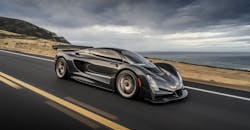The ingenuity bug bit Kevin Czinger early in life. Growing up in the Cleveland area, he is the youngest of five, and received a hands-on education about hot rodding and building fast cars from his auto mechanic brothers. He was also lucky enough to start reading at a fairly early age, often spending time at the local public library reading about high performance aircraft like Lockheed Martin’s SRS 71.The young Czinger quickly started thinking about the sciences and engineering, and what he could eventually create.
Fast forward a few years, and Czinger co-founded an electric vehicle company as well as a battery design and manufacturing company credited with designing one of the first automotive grade, prismatic cell battery management systems. The company also built a million square foot mega factory to manufacture batteries.
The culmination of these experiences ultimately led Czinger to belief that the current mode of manufacturing needed to catch up to the digital age. And Czinger's recent release of the 21C hyper car demonstrates the possibilities. The 21C sports the use of proprietary manufacturing technologies, in-house developed drivetrain and unique design elements that promise to guide production of a series of exclusive performance vehicles.
“It’s an opportunity to look at manufacturing with a completely fresh standpoint, embracing all a digital manufacturing system can offer instead of using a 100-year-old system,” he says.
Printing a new path
And, while digitally generating an optimized structure is great, manufacturers need to be able to transfer that digital creation into reality. That's where additive manufacturing enters the equation. Of course, optimization for production environments means being able to scale economically with performance results.
Leveraging a joint development agreement with SLM Solutions, Czinger prints (and ultimately assembles finished parts) at a very different rate using unique materials and software.
Eye on the road
Czinger tells IndustryWeek, his goal is not to compete with the big auto companies. Instead, he is creating a set of niche vehicles built at the limits of imagination and technology. “21C is totally, crazily off the hook, but it showcases cutting-edge technology and cutting-edge ideas, everything from aesthetics, design, different configurations and different functional cases,” he says.
Building a car like the 21C is the ability to provide proof, explains Czinger. “For instance, if an automaker needs a front upper control arm, they can send us hard points and keep-out zone and we will generate a design, test it, and send all of the material test cards. It’s about sharing our data to show it can be designed, printed and perform,” he says. “We'll do the same thing with a 17-piece subframe automatically assembled using our technology and materials. It gets you thinking about things like engineering in functional components like heat exchangers or load bearing structures.”
Just getting started
Revitalizing the auto industry is in vogue with an intensified focus on EVs. However, Czinger does not see the current move towards EV as the solution. His view is echoed in a recent Goldman Sachs report about the need for a life cycle approach, understanding the environmental impact means looking at vehicle emission, the extractive pollution from mining, the pollution from manufacturing, the pollution from the powering of things (generation of electricity or fuels) and then the end use disposal/recycling.
“The way to mitigate those material and energy flows, is through dematerialization rate, which means we need to focus on lighter, more efficient vehicles not just looking at what’s coming out of the tailpipe,” he says. “The good news is with today’s technology we can focus on doing full analysis, developing the right materials, and getting dematerialization rate up, even for these complex structures.”
As an IATF 16949-2016 fully certified tier-one supplier, Czinger is already working with a few global automotive manufacturing groups, entering at lower volumes (thousands to low 10s of thousands) of vehicles suspension structures and full vehicle structures, and then quickly moving to higher volume vehicles. The ultimate goal is to install and license a total end-to-end patented process that promises to radically change how companies look at manufacturing and assembling vehicle systems.
“Our focus is the core of the auto industry and what's broken. This is an industry that is not breaking even and hasn't for almost a decade,” he says.
About the Author
Peter Fretty
Technology Editor
As a highly experienced journalist, Peter Fretty regularly covers advances in manufacturing, information technology, and software. He has written thousands of feature articles, cover stories, and white papers for an assortment of trade journals, business publications, and consumer magazines.
